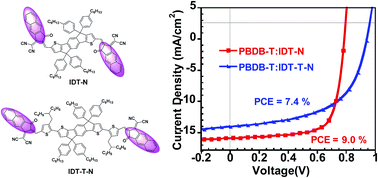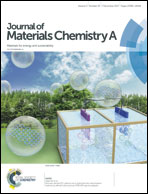Non-fullerene acceptors based on fused-ring oligomers for efficient polymer solar cells via complementary light-absorption†
Abstract
We designed and synthesized two novel non-fullerene small molecule acceptors (IDT-N and IDT-T-N) that consist of indacenodithiophene (IDT) as the electron-donating core and 2-(3-oxo-2,3-dihydro-1H-cyclopenta[b]naphthalen-1-ylidene)malononitrile (N) as a novel electron-withdrawing end group. IDT-N and IDT-T-N consisting of the naphthyl-based N group exhibited an expanded plane compared to phenyl-based indanone (INCN), which strengthened the intramolecular push–pull effect between the core donor unit and the terminal acceptor units. This strengthened effect resulted in a reduced bandgap that was beneficial for solar photon collection and increased short-circuit current density of the resulting devices. IDT-N and IDT-T-N exhibited red-shifted absorptions and smaller optical bandgaps than the corresponding phenyl-fused indanone end-capped chromophores. Both acceptors exhibited broad absorptions and energy levels that were well-matched with the donor materials. Polymer solar cells based on IDT-N and IDT-T-N and two representative polymer donors (PTB7-Th and PBDB-T) exhibited impressive photovoltaic performances. The devices based on the PBDB-T:IDT-N system exhibited a power conversion efficiency of up to 9.0%, with a short-circuit current density of 15.88 mA cm−2 and a fill factor of 71.91%. These results demonstrate that IDT-N and IDT-T-N are promising electron acceptors for use in polymer solar cells.



 Please wait while we load your content...
Please wait while we load your content...